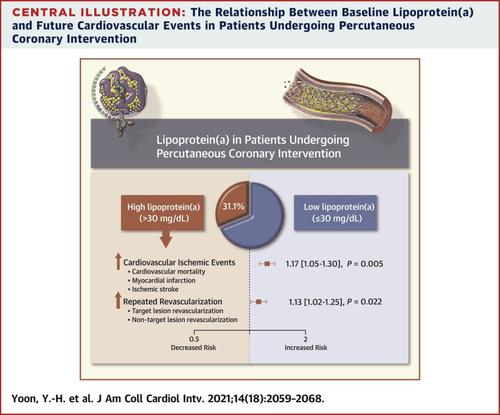JACC: Cardiovascular Interventions ( IF 11.7 ) Pub Date : 2021-09-20 , DOI: 10.1016/j.jcin.2021.07.042 Yong-Hoon Yoon 1 , Jung-Min Ahn 2 , Do-Yoon Kang 2 , Pil Hyung Lee 2 , Soo-Jin Kang 2 , Duk-Woo Park 2 , Seung-Whan Lee 2 , Young-Hak Kim 2 , Ki Hoon Han 2 , Cheol Whan Lee 2 , Seong-Wook Park 2 , Seung-Jung Park 2

|
Objectives
This study evaluated the association between elevated levels of lipoprotein(a) [Lp(a)] and risk of recurrent ischemic events in patients who underwent percutaneous coronary intervention (PCI).
Background
Elevated levels of Lp(a) have been identified as an independent, possibly causal, risk factor for atherosclerotic cardiovascular disease in a general population study.
Methods
A prospective single-center registry was used to identify 12,064 patients with baseline Lp(a) measurements who underwent PCI between 2003 and 2013. The primary outcomes were a composite of cardiovascular death, spontaneous myocardial infarction, and ischemic stroke.
Results
From the registry, 3,747 (31.1%) patients had high Lp(a) (>30 mg/dL) and 8,317 (68.9%) patients had low Lp(a) (≤30 mg/dL). During a median follow-up of 7.4 years, primary outcomes occurred in 1,490 patients, and the incidence rates of primary outcomes were 2.0 per 100 person-years in the high-Lp(a) group and 1.6 per 100 person-years in the low-Lp(a) group (adjusted hazard ratio [aHR]: 1.17; 95% confidence interval [CI]: 1.05-1.30; P = 0.004). Increased risk of recurrent ischemic cardiovascular events in the high-Lp(a) group was consistent in various subgroups including patients receiving statin treatment at discharge (aHR: 1.18; 95% CI: 1.03-1.34; P = 0.011). In addition, the risk of repeated revascularization was significantly higher in the high-Lp(a) group (aHR: 1.13; 95% CI: 1.02-1.25; P = 0.022).
Conclusions
Elevated levels of Lp(a) were significantly associated with the recurrent ischemic events in patients who underwent PCI. This study provides a rationale for outcome trials to test Lp(a)-lowering therapy for secondary prevention in patients undergoing PCI.
中文翻译:

脂蛋白 (a) 与经皮冠状动脉介入治疗后复发性缺血事件的关联
目标
本研究评估了接受经皮冠状动脉介入治疗 (PCI) 的患者的脂蛋白 (a) [Lp(a)] 水平升高与缺血事件复发风险之间的关联。
背景
在一项普通人群研究中,Lp(a) 水平升高已被确定为动脉粥样硬化性心血管疾病的一个独立的、可能的因果风险因素。
方法
一项前瞻性单中心注册用于确定 2003 年至 2013 年间接受 PCI 的 12,064 名具有基线 Lp(a) 测量值的患者。主要结局是心血管死亡、自发性心肌梗死和缺血性卒中的复合结局。
结果
从注册中,3,747 (31.1%) 名患者具有高 Lp(a) (>30 mg/dL) 和 8,317 (68.9%) 名患者具有低 Lp(a) (≤30 mg/dL)。在 7.4 年的中位随访期间,1,490 名患者发生了主要结局,主要结局的发生率在高 Lp(a) 组中为每 100 人年 2.0,在低 Lp(a) 组中为每 100 人年 1.6 -Lp(a) 组(调整后的风险比 [aHR]:1.17;95% 置信区间 [CI]:1.05-1.30;P = 0.004)。高 Lp(a) 组复发性缺血性心血管事件的风险增加在包括出院时接受他汀类药物治疗的患者在内的各个亚组中一致(aHR:1.18;95% CI:1.03-1.34;P =0.011)。此外,高 Lp(a) 组重复血运重建的风险显着更高(aHR:1.13;95% CI:1.02-1.25;P = 0.022)。
结论
在接受 PCI 的患者中,Lp(a) 水平升高与复发性缺血事件显着相关。这项研究为结果试验提供了理论依据,以测试降低 Lp(a) 治疗对接受 PCI 的患者的二级预防。









































 京公网安备 11010802027423号
京公网安备 11010802027423号